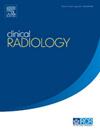定量胸部计算机断层扫描:双能量衍生虚拟与真实非对比扫描的区域差异
IF 2.1
3区 医学
Q2 RADIOLOGY, NUCLEAR MEDICINE & MEDICAL IMAGING
引用次数: 0
摘要
目的胸部计算机断层扫描(CT)的定量分析通常需要非对比扫描。多能ct衍生的虚拟无对比(VNC)图像可以避免额外的真无对比(TNC)扫描。我们的目的是定量比较虚拟和真实的非对比图像,重点是肺组织的区域差异。材料和方法该双中心回顾性研究经irb批准,纳入了2018年4月至2022年12月一年内连续接受对比增强双能和非对比胸部CT扫描的患者。扫描被共同注册并半人工分割成不同的感兴趣的体积:全肺、中心/周围、腹侧/背侧一半和上/中/下三分之一。通过VNC和TNC扫描计算每个体积的平均肺密度,高和低衰减体积以及低15百分位数。相关性和一致性评估采用皮尔逊和类内相关系数和Bland-Altman分析。亚组分析包括身体质量指数和肺气肿标志物。结果纳入48例患者(女性26例,中位年龄63岁,四分位数范围58 ~ 69岁)。皮尔逊相关系数和类内相关系数>;0.9表明平均肺密度、低衰减体积和整个肺的低15百分位具有高度的相关性和一致性。高衰减体积的一致性稍不明显(类内相关系数为0.84[95%置信区间:0.73,0.91])。区域间存在差异,例如,平均肺密度(HUVNC减去HUTNC)上、中、下三分之一的平均差异分别为-5.71 HU[-11.07, -0.35]、1.62 HU[-2.98, 6.23]和5.77 HU[-0.47, 12.01]。结论虽然观察到轻微的区域差异,但使用VNC图像可以可靠地进行定量分析。本文章由计算机程序翻译,如有差异,请以英文原文为准。
Quantitative chest computed tomography: regional differences in dual-energy-derived virtual vs. true non-contrast scans
Aim
Quantitative analysis of chest computed tomography (CT) usually requires non-contrast scans. Multi-energy CT-derived virtual non-contrast (VNC) images may obviate additional true non-contrast (TNC) scans. We aimed to quantitatively compare virtual and true non-contrast images, with a focus on regional differences in pulmonary tissue.
Materials and Methods
This bi-center retrospective, IRB-approved study included consecutive patients who received contrast-enhanced dual-energy and non-contrast chest CT scans within one year between April 2018 and December 2022. Scans were co-registered and semi-manually segmented into various volumes of interest: whole lung, center/periphery, ventral/dorsal half and upper/middle/lower third. The mean lung density, high and low attenuation volumes and the lower 15th percentile were computed from the VNC and TNC scans for each volume. Correlation and agreement were assessed using Pearson’s and intraclass correlation coefficients and Bland–Altman analysis. Subgroup analyses involved body mass index and markers of pulmonary emphysema.
Results
Forty-eight patients were included (26 females, median age: 63 years, interquartile range: 58–69). Pearson’s and intraclass correlation coefficients > 0.9 demonstrated high correlation and agreement for the mean lung density, low attenuation volume and the lower 15th percentile across the whole lung. The agreement for high attenuation volume was slightly less pronounced (intraclass correlation coefficient, 0.84 [95% confidence interval: 0.73, 0.91]). Regional differences were observed, for example, concerning the mean lung density with mean differences (HUVNC minus HUTNC) of -5.71 HU [-11.07, -0.35], 1.62 HU [-2.98, 6.23] and 5.77 HU [-0.47, 12.01] for the upper, middle and lower third, respectively.
Conclusion
Although slight regional differences were observed, quantitative analysis can be reliably performed using VNC images.
求助全文
通过发布文献求助,成功后即可免费获取论文全文。
去求助
来源期刊

Clinical radiology
医学-核医学
CiteScore
4.70
自引率
3.80%
发文量
528
审稿时长
76 days
期刊介绍:
Clinical Radiology is published by Elsevier on behalf of The Royal College of Radiologists. Clinical Radiology is an International Journal bringing you original research, editorials and review articles on all aspects of diagnostic imaging, including:
• Computed tomography
• Magnetic resonance imaging
• Ultrasonography
• Digital radiology
• Interventional radiology
• Radiography
• Nuclear medicine
Papers on radiological protection, quality assurance, audit in radiology and matters relating to radiological training and education are also included. In addition, each issue contains correspondence, book reviews and notices of forthcoming events.
 求助内容:
求助内容: 应助结果提醒方式:
应助结果提醒方式:


